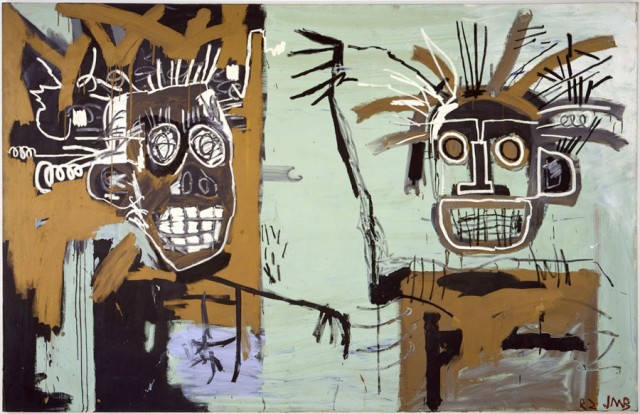
Jean-Michel Basquiat, “Untitled (Two Heads on Gold),” acrylic and oil paintstick on canvas, 1982 (© the Estate of Jean-Michel Basquiat/ADAGP, Paris, ARS, New York 2013)
Gagosian Gallery
555 West 24th St. between Tenth & Eleventh Aves.
Through April 6, free, 10:00 am – 6:00 pm
212-741-1111
www.gagosian.com
You can expect tremendous crowds Friday and Saturday at Gagosian’s West 24th St. space as the blockbuster “Jean-Michel Basquiat” exhibition comes to a close. Eight years ago, the Brooklyn Museum presented the revelatory, chronological “Basquiat,” which cast the street-artist-turned-Warhol-progeny in a whole new spotlight, displaying his awe-inspiring talent from his early days as a graffiti artist to his drug-addled, rambling final canvases prior to his overdose death in 1988 at the age of twenty-seven. This show comes as financial interest in Basquiat is reaching new peaks, with an untitled 1981 work selling for $16.3 million at Phillips de Pury & Company last year and the Wall Street Journal reporting that the Brooklyn-born artist’s 1982 “Dustheads” will be auctioned at Christie’s next month for an expected $25-$35 million. The Gagosian show consists of nearly fifty paintings, hung conceptually, with each work getting plenty of breathing room, the better to be enjoyed both on its own merits and in context of the glam punk’s greater oeuvre. The museum-quality exhibition highlights Basquiat’s bold, brash sense of color and often violent brushstrokes along with his intriguing use of words and language, his love of jazz and boxing, and such repeated imagery as crowns, halos, and the copyright symbol.
There’s both an anger and a primitivism in his work that continues to draw a diverse, still-growing audience: We feel his pain; we understand his desperate need to express himself. Basquiat is that rare street artist whose work still manages to come alive in a gallery or museum setting, whether on canvas, a door, or a wooden fence. In pieces such as “La Hara” and “Untitled (Two Heads on Gold),” the abstract characters seem to jump off the canvas as if living, breathing figures. Words instantly imbued with meaning leap out at us in such canvases as “In Italian” (“sangre,” “liberty,” “blood,” “teeth,” “corpus”) and “Revised Undiscovered Genius of the Mississippi Delta” (“Mark Twain,” “Negroes,” “Udder,” “Cotton,” “The Deep South,” “El Raton”). Sneaker prints hover in the background of “Eyes and Eggs,” as if Basquiat stepped over his depiction of a short-order cook. All these years later, we still see Basquiat as one of us, speaking for the disenfranchised, the forgotten, the poor, the trod upon, someone who rose out of the streets, perhaps like any of us can, despite his tragic end. The Gagosian show presents Basquiat as a graffiti poet and a jazz musician, emitting dazzling sounds and rhythms that move the heart and soul.